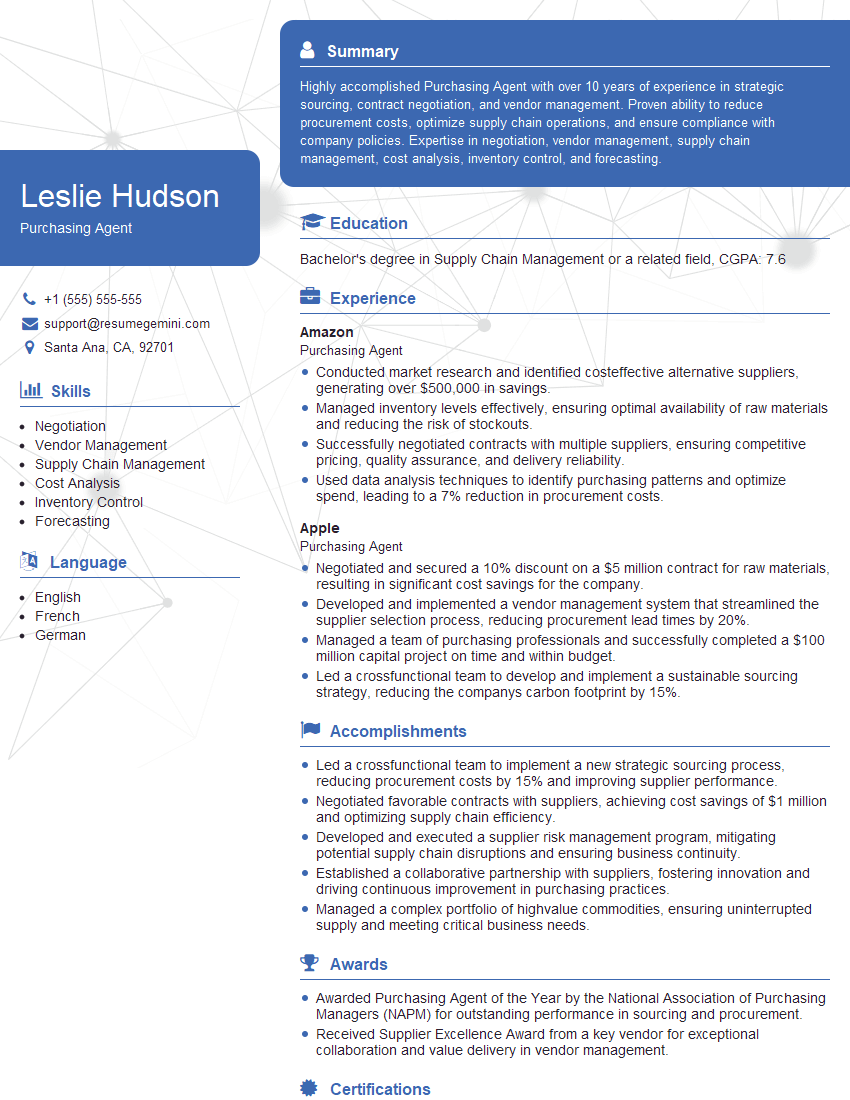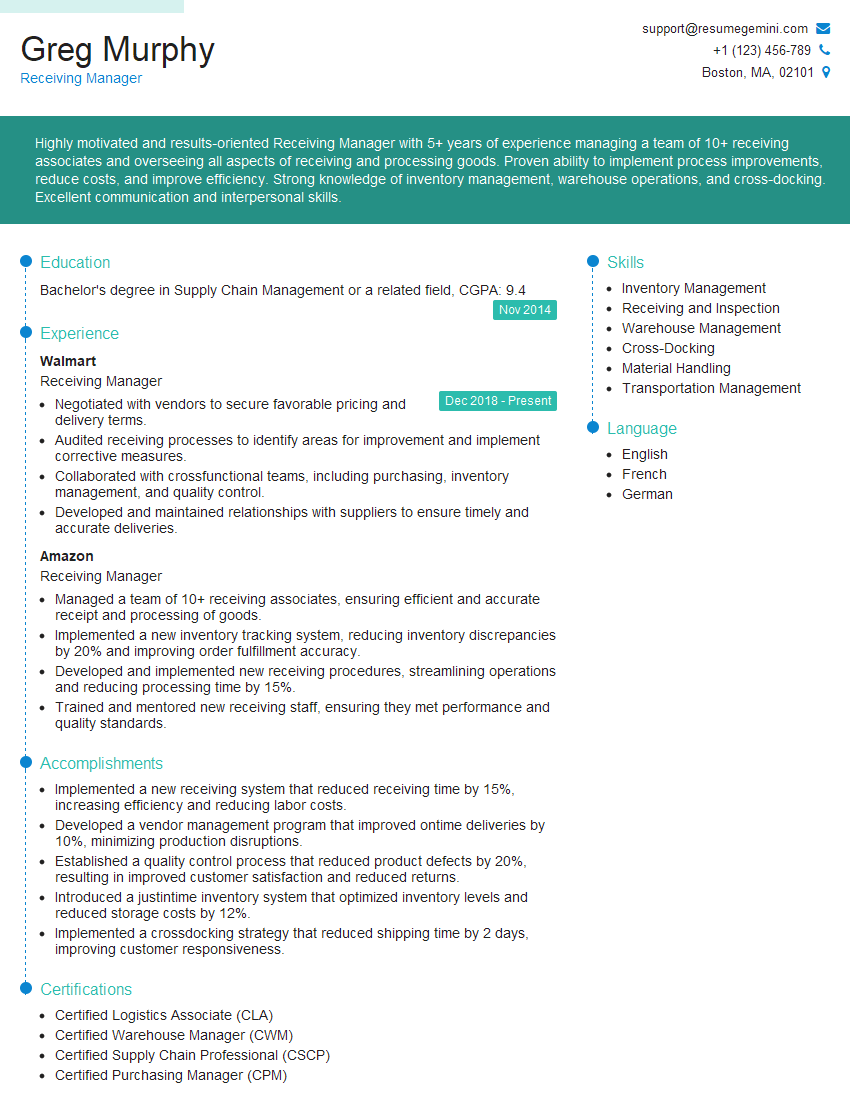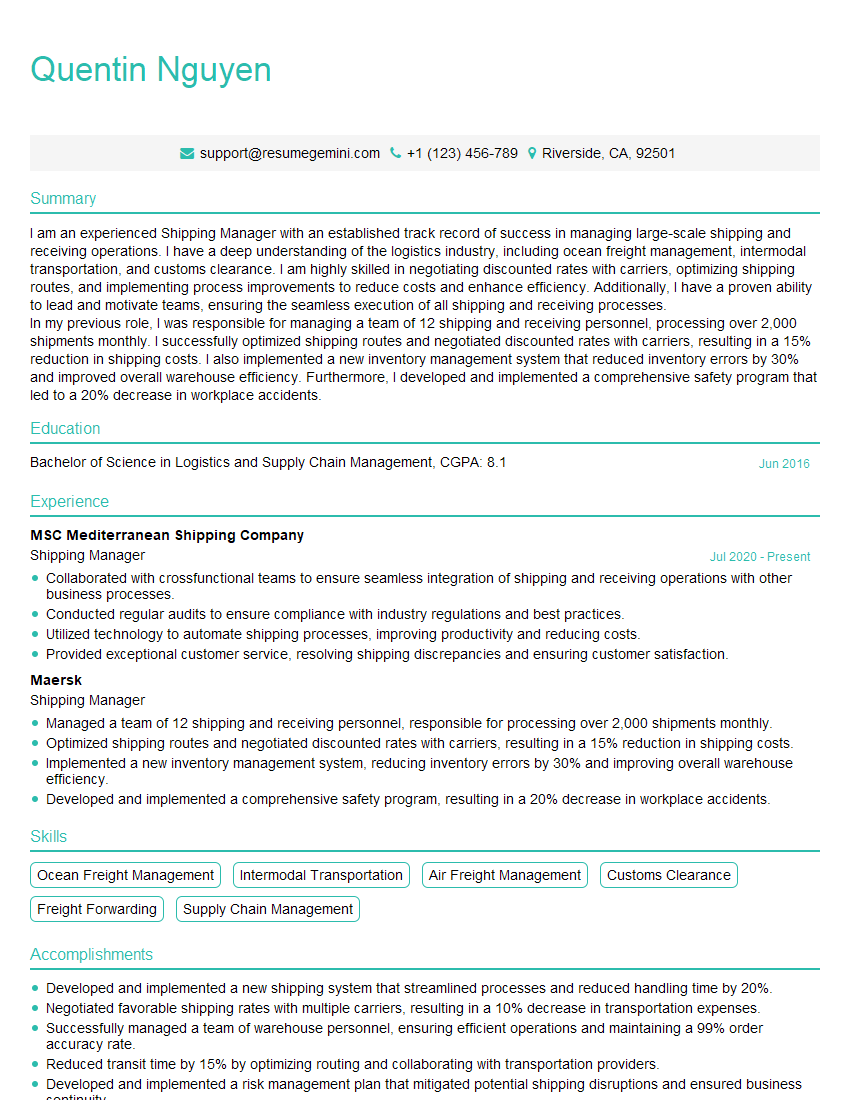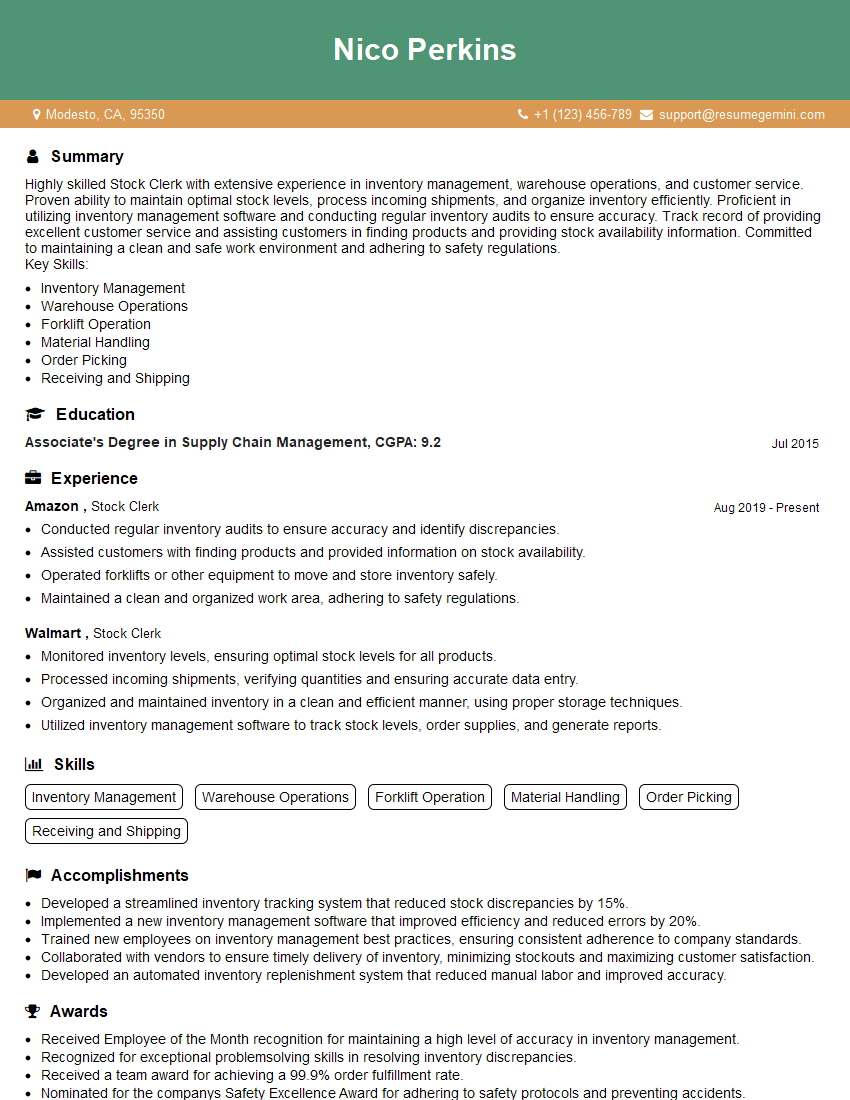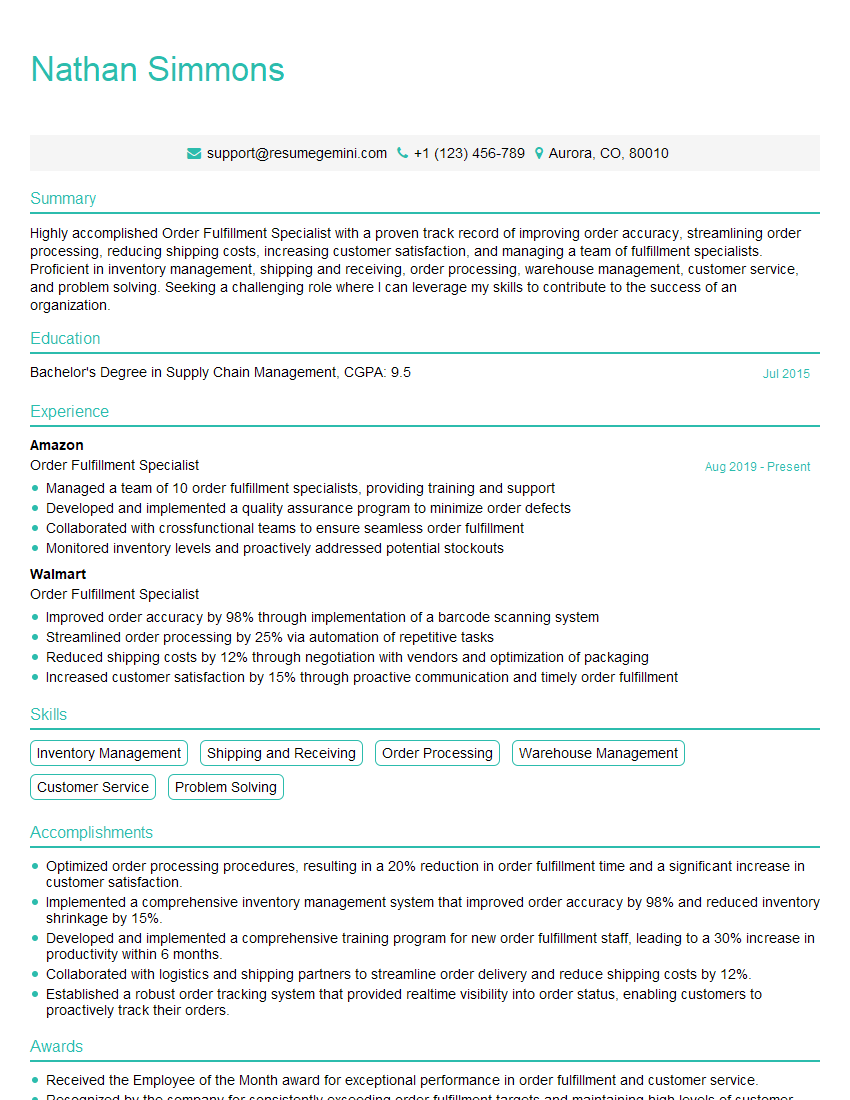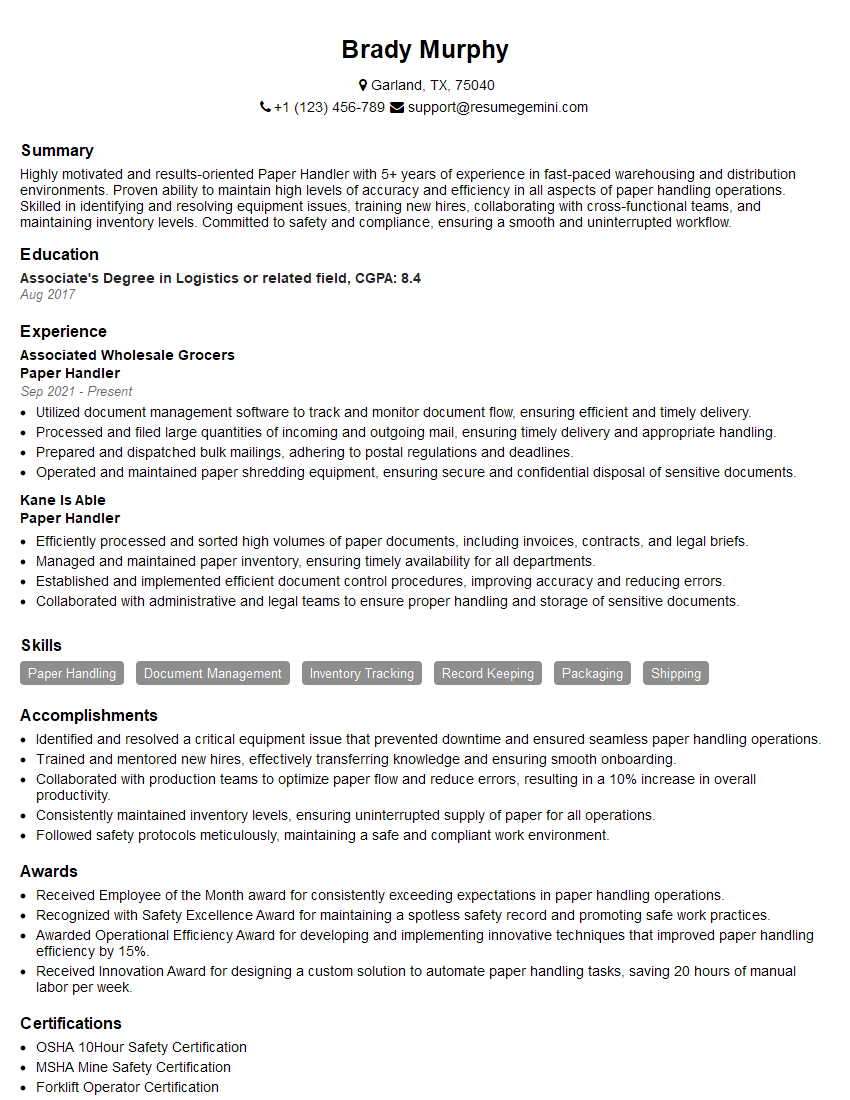Cracking a skill-specific interview, like one for Paper Handling and Inventory Management, requires understanding the nuances of the role. In this blog, we present the questions you’re most likely to encounter, along with insights into how to answer them effectively. Let’s ensure you’re ready to make a strong impression.
Questions Asked in Paper Handling and Inventory Management Interview
Q 1. Describe your experience with different paper handling equipment (e.g., scanners, shredders, folders).
My experience with paper handling equipment is extensive, encompassing a wide range of technologies used in various office and industrial settings. I’m proficient with high-volume scanners, both flatbed and sheet-fed, understanding the nuances of different scanning resolutions and file formats (e.g., PDF, TIFF, JPEG). I’ve worked with various shredders, from small, personal models to high-security industrial cross-cut shredders, understanding the importance of appropriate security levels for different document types and compliance regulations. Finally, I have experience with various folding and collating machines, understanding how to optimize these processes for efficiency and accuracy, depending on the specific paper size and required output.
For example, in a previous role, I implemented a new high-speed scanner that increased our document digitization rate by 40%, significantly reducing processing time and improving workflow efficiency. I also oversaw the selection and implementation of a new shredder that met stringent security standards for sensitive client data.
Q 2. Explain your understanding of FIFO (First-In, First-Out) and LIFO (Last-In, First-Out) inventory methods.
FIFO (First-In, First-Out) and LIFO (Last-In, First-Out) are two common inventory management methods. Imagine a stack of plates; FIFO is like taking the bottom plate first (oldest), while LIFO is like taking the top plate first (newest).
FIFO ensures that older items are used or sold first, minimizing the risk of spoilage or obsolescence, especially relevant for perishable goods or items with expiration dates. This is ideal for paper that might degrade over time.
LIFO, on the other hand, means the most recently received items are used first. While it might seem counterintuitive, LIFO can be advantageous for items whose value fluctuates with market prices; it can lead to lower taxable income during periods of inflation as the cost of goods sold is higher.
Choosing between FIFO and LIFO depends on the specific characteristics of the inventory and business goals. For paper inventory, FIFO is generally preferred to prevent waste due to aging or damage.
Q 3. How do you track inventory levels accurately?
Accurate inventory tracking requires a multi-pronged approach. This involves combining physical counts with a robust inventory management system. Regularly scheduled physical inventory counts, ideally using a cyclical counting method rather than a complete annual count, help identify discrepancies early. Each count should be documented meticulously. Simultaneously, a computerized inventory management system, updated with every transaction (incoming and outgoing), provides a real-time view of stock levels. This system can be integrated with the purchasing and distribution processes for automated updates. Barcode or RFID tagging enables faster and more accurate counting.
For example, in my previous role, we implemented a system where a small team performed a physical count of a specific section of the warehouse each week, ensuring complete inventory verification over the course of a month. This was reconciled with the digital inventory record to highlight any issues immediately.
Q 4. What strategies do you use to prevent paper jams and other handling issues?
Preventing paper jams and handling issues requires proactive measures and a focus on proper equipment maintenance. Regular cleaning of paper trays and rollers is crucial to remove dust and debris that can cause jams. Using the correct paper type and weight for the equipment is essential. Ensuring that paper is properly aligned and fed into the machine prevents misfeeds. Regular maintenance checks, including lubrication of moving parts and checking for wear and tear, should be conducted according to the manufacturer’s guidelines. Proper training for employees on the correct handling procedures and troubleshooting basic jams also minimizes issues.
Imagine a car engine; regular maintenance and the right fuel ensure smooth operation. Similarly, with paper handling equipment, consistent upkeep minimizes disruptions.
Q 5. How do you maintain the security and confidentiality of paper documents?
Maintaining the security and confidentiality of paper documents requires a layered approach. This includes secure storage solutions, such as locked cabinets or rooms with restricted access, for sensitive materials. Implementing controlled access policies, with designated personnel responsible for document handling, is vital. Shredding confidential documents immediately after their use is crucial, using appropriate security level shredders for different sensitivity levels. Proper disposal methods, including secure off-site destruction for particularly sensitive materials, should be utilized. Regular audits of security protocols can identify and address potential weaknesses.
For instance, a previous employer utilized a two-person verification system for accessing confidential files, ensuring accountability and reducing the risk of unauthorized access.
Q 6. Describe your experience with inventory management software.
My experience with inventory management software encompasses various systems, from simple spreadsheet-based solutions to sophisticated enterprise resource planning (ERP) systems. I’m proficient in using software to track inventory levels, generate reports, manage purchase orders, and analyze inventory trends. I understand the importance of choosing a system that integrates seamlessly with other business processes, allowing for efficient data flow and accurate reporting. My experience also includes data migration and system implementation, ensuring accurate transfer of data and minimal disruption to workflow.
I’ve worked with systems like SAP, Oracle, and more streamlined solutions depending on the needs of the organization. The key is to choose a system that provides visibility and control over the inventory process while minimizing manual entry and potential errors.
Q 7. How do you handle discrepancies between physical inventory and recorded inventory?
Discrepancies between physical inventory and recorded inventory necessitate a thorough investigation to identify the root cause. This process begins with a recount of the affected inventory to confirm the physical count. Next, a detailed review of the inventory management system’s records is performed, checking for potential data entry errors, system glitches, or inaccurate transactions. Potential causes could be theft, damage, inaccurate recording of shipments, or misplacement of items. Once the cause is identified, corrective measures are implemented to prevent future discrepancies. This could include improved training for personnel, enhanced security measures, or system upgrades to enhance accuracy.
For example, in one case, a discrepancy was traced back to a faulty barcode scanner, highlighting the importance of regular equipment maintenance and calibration.
Q 8. How do you manage damaged or obsolete paper stock?
Managing damaged or obsolete paper stock requires a multi-faceted approach focusing on identification, segregation, and disposal or repurposing. First, we establish clear criteria for identifying damaged goods – this might include discoloration, moisture damage, or significant tearing. Obsolete stock is identified by tracking paper usage trends and recognizing slow-moving or outdated paper types. Once identified, damaged and obsolete stock is segregated from usable inventory, ideally in a designated area to prevent accidental use. This prevents further losses.
Next, we evaluate options for disposal or repurposing. Slightly damaged paper might be suitable for internal drafts or less critical documents. Larger quantities of damaged or obsolete paper can be responsibly recycled, often through partnerships with recycling companies. We maintain meticulous records of disposal methods to ensure environmental compliance. Finally, regular stock audits help prevent the accumulation of damaged and obsolete paper in the first place by identifying slow-moving items early on and allowing for proactive adjustments to purchasing strategies.
Q 9. What are your methods for organizing and storing large volumes of paper documents?
Organizing and storing large volumes of paper documents demands a systematic approach. The first step is establishing a clear filing system. This usually involves a combination of alphanumeric codes and descriptive labels. Consider using a hierarchical system, such as departmental filing, followed by chronological or project-based sub-folders.
Storage itself should utilize appropriate shelving, ideally mobile shelving units to maximize space utilization in a warehouse or storage room. Consider the environmental conditions – temperature and humidity control are essential to prevent paper degradation. We must maintain strict access control, limiting access to authorized personnel to ensure document security and prevent unauthorized access. Finally, regular audits are crucial to ensure that the system remains organized and efficient, identifying and addressing any gaps or inefficiencies.
For example, in a previous role, we implemented a color-coded filing system, where each department was assigned a color, and further sub-divisions within the department were designated by different shades of that color. This made it incredibly easy to locate documents quickly and efficiently.
Q 10. Explain your experience with cycle counting.
Cycle counting is a crucial inventory management technique that involves counting a small subset of inventory on a regular schedule rather than a full inventory count at a specific point in time. This allows for continuous monitoring of inventory accuracy. My experience includes implementing and managing cycle counting programs in various settings, often using a stratified approach – high-value or high-movement items are counted more frequently than low-value, low-movement items.
I use software to schedule counts and track discrepancies. The software generates reports that highlight any significant differences between the physical count and the recorded inventory. This data helps identify areas needing improvement in our processes and informs purchasing decisions. Regular cycle counts help minimize the impact of stock-outs and overstocking. For example, in a previous role, implementing cycle counting reduced inventory discrepancies by 25% within six months.
Q 11. How do you prioritize tasks when faced with multiple inventory management responsibilities?
Prioritizing tasks in inventory management involves a combination of urgency, importance, and impact. I typically use a prioritization matrix, often visualizing it with a simple chart listing tasks across urgency and importance axes. Urgent and important tasks, like addressing an immediate stock-out, take priority. Important but not urgent tasks, such as implementing a new inventory tracking system, are scheduled in advance.
Less important tasks might be delegated or deferred until there is more capacity. Factors like potential cost savings or revenue generation also influence prioritization. I also leverage project management tools to track progress and ensure deadlines are met. This systematic approach prevents feeling overwhelmed and ensures that critical tasks are addressed promptly and efficiently.
Q 12. Describe your experience with barcode scanning and other inventory tracking technologies.
I have extensive experience with barcode scanning and other inventory tracking technologies. Barcode scanning is integral to accurate and efficient inventory management. It significantly reduces manual data entry errors and speeds up the counting process. I’m proficient in using various barcode scanners, handheld and fixed, and integrating their data with inventory management systems.
Beyond barcodes, I’ve worked with RFID (Radio-Frequency Identification) technology for tracking high-value or sensitive items. RFID offers greater tracking capabilities than barcodes, allowing for real-time monitoring of inventory location and movement. My experience includes data analysis from these systems to identify trends, potential issues, and areas for process improvement. For instance, in one company we implemented RFID tracking for high-value printing paper, which resulted in a significant reduction in losses due to theft or misplacement.
Q 13. How do you ensure efficient and timely order fulfillment?
Ensuring efficient and timely order fulfillment relies on accurate inventory data, streamlined processes, and effective communication. Accurate forecasting is crucial; understanding demand patterns helps in predicting order volumes and optimizing stock levels. This prevents both stock-outs and overstocking.
We should have well-defined order picking and packing procedures, possibly employing techniques such as zone picking or batch picking to improve efficiency. Efficient shipping arrangements are vital, selecting cost-effective carriers and negotiating favorable rates. Real-time order tracking provides transparency for customers and allows for quick responses to any potential delays. Finally, clear communication with both internal teams and customers ensures that everyone is informed about the status of orders and any potential issues.
Q 14. How familiar are you with different inventory valuation methods?
I’m familiar with several inventory valuation methods, including First-In, First-Out (FIFO), Last-In, First-Out (LIFO), and Weighted-Average Cost. FIFO assumes that the oldest items are sold first, while LIFO assumes the newest items are sold first. The Weighted-Average Cost method calculates the average cost of all items in inventory.
The choice of method impacts the cost of goods sold and the value of ending inventory reported on financial statements. FIFO is often preferred as it reflects the actual flow of goods and results in a more accurate representation of the value of inventory. LIFO can be beneficial in times of inflation as it can lead to lower reported income and thus lower tax liabilities, but it can also distort the reported cost of goods sold. Understanding the implications of each method is crucial for accurate financial reporting and decision-making. My experience includes selecting and implementing the most appropriate method based on the specific characteristics of the inventory and the company’s accounting standards.
Q 15. What are your strategies for optimizing warehouse space and improving workflow?
Optimizing warehouse space and workflow requires a holistic approach combining strategic planning and efficient execution. Think of it like organizing a highly efficient orchestra – each instrument (task and resource) needs to be in the right place at the right time to create beautiful (efficient) output.
- Strategic Space Allocation: I begin by analyzing the warehouse layout, considering factors like product demand, frequency of access, and storage capacity. Fast-moving items get prime, easily accessible locations, minimizing travel time. Slow-moving items can be stored in less accessible areas. This is often done using ABC analysis, categorizing inventory based on value and usage.
- Efficient Picking Routes: Implementing optimized picking routes, such as using the ‘shortest route’ or ‘cluster picking’ methods, reduces travel time significantly. Software can generate optimal routes based on order data, and handheld scanners can guide workers through the warehouse.
- Vertical Space Utilization: Maximize vertical space by utilizing high-bay racking systems, allowing for more storage in the same footprint. This could be supplemented by mezzanine floors to increase overall storage capacity.
- Lean Principles: Applying lean methodologies, such as eliminating waste (muda), reduces unnecessary movement and waiting time. This often involves improving processes like order fulfillment and reducing excess inventory.
- Technology Integration: Warehouse Management Systems (WMS) are crucial. They provide real-time inventory tracking, optimize picking routes, and manage labor effectively. Automated guided vehicles (AGVs) or robots can further streamline processes.
For example, in a previous role, we implemented a new WMS that reduced order fulfillment time by 20% and increased worker productivity by 15%. This involved reorganizing the warehouse layout and training employees on the new system.
Career Expert Tips:
- Ace those interviews! Prepare effectively by reviewing the Top 50 Most Common Interview Questions on ResumeGemini.
- Navigate your job search with confidence! Explore a wide range of Career Tips on ResumeGemini. Learn about common challenges and recommendations to overcome them.
- Craft the perfect resume! Master the Art of Resume Writing with ResumeGemini’s guide. Showcase your unique qualifications and achievements effectively.
- Don’t miss out on holiday savings! Build your dream resume with ResumeGemini’s ATS optimized templates.
Q 16. How do you handle returns and damaged goods?
Handling returns and damaged goods efficiently is critical for maintaining inventory accuracy and minimizing losses. It’s like triage in a hospital – you need a system to quickly assess, treat, and dispose of issues.
- Clear Return Policy: Establish a clear and concise return policy, ensuring that customers understand the process and requirements. This helps minimize disputes and confusion.
- Designated Receiving Area: Create a dedicated area for processing returns, separate from the main receiving dock. This area should have adequate space for inspecting, sorting, and storing returned goods.
- Inspection and Grading: Develop a standardized process for inspecting returned items. This involves assessing their condition to determine if they are resalable, repairable, or need to be discarded. Grading systems ensure consistency in assessing the condition of the returns.
- Inventory Management System Update: The WMS should be updated immediately to reflect the changes in inventory levels caused by returns and damaged goods. This ensures accuracy in inventory reporting and forecasting.
- Disposal and Recycling: Establish a procedure for disposing of or recycling damaged or unsalvageable items, following all relevant environmental regulations. This might involve working with a recycling company.
For instance, I implemented a system where returned items were immediately inspected and scanned using barcodes, updating the inventory database in real-time. This reduced the time to process returns by 30% and prevented inaccuracies in inventory levels.
Q 17. Describe your experience with implementing new inventory management procedures.
Implementing new inventory management procedures is akin to building a new bridge – it requires careful planning, execution, and ongoing maintenance. It’s not just about installing new software; it’s about changing work habits and processes.
- Needs Assessment: Start with a thorough assessment of the current system, identifying pain points and areas for improvement. This may involve conducting interviews with staff, reviewing key performance indicators (KPIs), and analyzing data.
- Selection and Implementation of New System: Research and select a new system, or modify the existing one, that best addresses the identified needs. This involves considering factors such as cost, scalability, and integration with other systems. A phased rollout is usually preferable to a complete system change overnight.
- Training and Education: Provide comprehensive training to all staff members on the new procedures. This is essential to ensure adoption and proficiency in using the new system.
- Testing and Monitoring: Thoroughly test the new system before full implementation, and continually monitor its performance after implementation to identify and address any issues. Key performance indicators (KPIs) should be tracked to measure success.
- Feedback and Iteration: Gather feedback from staff and stakeholders throughout the implementation process. Be prepared to make adjustments based on this feedback, ensuring the system is optimized for efficiency and effectiveness.
In a previous role, I oversaw the implementation of a new RFID system for tracking inventory. This involved a phased rollout, starting with a pilot program in one warehouse before expanding to the rest. Regular feedback from staff ensured the system was tailored to their needs, resulting in improved inventory accuracy and reduced stockouts.
Q 18. How do you stay organized and manage your time effectively in a fast-paced warehouse environment?
Staying organized and managing time effectively in a fast-paced warehouse environment requires a structured approach, a bit like a well-oiled machine. Each part must function smoothly and predictably.
- Prioritization and Task Management: Use a task management system, whether digital or physical, to prioritize tasks based on urgency and importance. This ensures that critical tasks are completed promptly.
- Time Blocking: Allocate specific time slots for different tasks, maximizing productivity and minimizing distractions. This can be adapted to the flow of work within the warehouse.
- Communication and Collaboration: Maintain clear and effective communication with colleagues and supervisors to coordinate activities and resolve any issues quickly. Regular team meetings can address concerns and keep everyone on the same page.
- Delegation: Delegate tasks where appropriate to other team members, maximizing efficiency and allowing you to focus on higher-priority activities. This requires trust and clear communication.
- Continuous Improvement: Continuously look for ways to improve your workflow and time management strategies. Regular self-reflection can identify areas needing adjustment.
I personally use a combination of a digital task management application and a daily planner to prioritize my tasks and schedule my day. This helps me stay focused even during busy periods and ensures that all crucial tasks are completed.
Q 19. How do you identify and resolve inventory control issues?
Identifying and resolving inventory control issues requires a systematic approach. Think of it as detective work: gather clues, analyze them, and find the solution.
- Regular Inventory Counts: Conduct regular cycle counts to compare physical inventory with recorded data. Discrepancies indicate potential problems.
- Data Analysis: Analyze inventory data to identify trends and patterns. For example, frequently occurring stockouts could indicate inaccurate demand forecasting or poor ordering practices.
- Root Cause Analysis: When an issue is identified, conduct a root cause analysis to pinpoint the underlying problem. This involves examining all potential causes and determining the root of the issue.
- Process Improvement: Implement improvements to processes and procedures to prevent similar issues from occurring in the future. This might involve retraining staff, refining inventory management software, or optimizing warehouse layout.
- Technology Utilization: Utilize technology such as barcode scanners, RFID, and WMS to improve inventory accuracy and track items throughout the warehouse. This allows for faster identification and resolution of issues.
Once, I identified a consistent discrepancy in our inventory levels through regular cycle counts. Through root cause analysis, I discovered a problem with our scanning system, leading to improved data entry procedures and a significant reduction in inventory inaccuracies.
Q 20. What are your experience levels with different types of paper stock (e.g., bond paper, cardstock)?
My experience encompasses a wide range of paper stocks, understanding their properties and applications is vital for effective handling and storage. Each type has unique characteristics that influence its handling and storage requirements.
- Bond Paper: I have extensive experience with various weights and finishes of bond paper, understanding its use in printing, copying, and general office applications. Knowing its susceptibility to moisture and its relatively high strength is crucial for storage and handling.
- Cardstock: I am familiar with different types of cardstock, including coated and uncoated varieties, and understand their applications in brochures, business cards, and other high-quality printed materials. Their stiffness requires careful handling to prevent bending or damage.
- Specialty Papers: My experience also extends to specialty papers like parchment, textured papers, and colored papers, each with unique properties demanding specific storage and handling methods to prevent damage and maintain quality.
- Paper Sizes and Weights: I am knowledgeable about different paper sizes (e.g., letter, legal, A4) and weights (e.g., 20lb, 24lb), understanding how these factors affect storage and handling efficiency. This knowledge is critical for efficient space utilization and preventing damage.
- Paper Grades and Qualities: I understand the different grades and qualities of paper, relating them to their intended use and appropriate storage techniques. This ensures that the paper is maintained in optimal condition.
In a previous role, I was responsible for managing the inventory of a printing company with a wide range of paper stocks. My knowledge of different paper types allowed me to optimize storage space and implement handling procedures that minimized waste and prevented damage.
Q 21. Explain your understanding of safety procedures related to paper handling and storage.
Safety is paramount in any warehouse environment, especially when handling large quantities of paper. A safe warehouse is a productive warehouse.
- Proper Stacking and Storage: Paper should be stacked properly to prevent collapse, using appropriate pallets and racking systems. Overloading or improper stacking can lead to injuries from falling stacks.
- Aisle Space: Maintaining adequate aisle space allows for safe movement of forklifts and other machinery, minimizing the risk of accidents. Clear markings and signage are essential.
- Fire Prevention: Paper is highly flammable. Fire prevention measures, such as sprinkler systems, fire extinguishers, and no-smoking policies, are essential to prevent fire hazards.
- Personal Protective Equipment (PPE): Appropriate PPE, such as safety gloves, safety shoes, and eye protection, should be used when handling paper, especially heavy rolls or stacks. This minimizes risk of injury from sharp edges or heavy loads.
- Ergonomics: Proper lifting techniques and ergonomic practices should be employed to prevent back injuries. Providing appropriate equipment and training can greatly reduce the risk of work-related injuries.
- Regular Inspections: Regular inspections of the warehouse and storage areas are crucial to identify and address potential safety hazards promptly. This proactive approach prevents accidents and keeps the workplace safe.
I’ve been involved in implementing safety training programs and implementing safety protocols that resulted in a significant reduction in workplace accidents in previous roles. Safety is not an add-on, it’s fundamental to our operations.
Q 22. How do you ensure proper disposal of confidential paper documents?
Ensuring the proper disposal of confidential paper documents is paramount for maintaining data security and compliance. This involves a multi-step process focusing on secure destruction and record-keeping. It’s not just about throwing documents in the trash.
- Secure Shredding: All confidential documents, including those with Personally Identifiable Information (PII) or sensitive business data, should be shredded using a cross-cut shredder to prevent reconstruction. This is the most effective method.
- Secure Transportation: If using an external shredding service, documents must be transported in locked containers to prevent unauthorized access. This requires verifying the service’s security protocols.
- Certification of Destruction: Many professional shredding services provide certificates of destruction as proof that the documents were properly disposed of. This is vital for audits and compliance.
- Internal Policies and Training: Clear internal policies on document disposal, along with employee training, are essential. Employees must understand the importance of secure disposal and know where to locate designated secure bins or containers.
- Retention Policies: Maintaining a robust document retention policy is crucial. This policy dictates how long documents need to be kept before secure disposal, complying with legal and regulatory requirements.
For example, in my previous role, we implemented a color-coded system for confidential documents. Red bins were for immediate shredding, while yellow bins were for documents needing temporary storage before shredding. This streamlined the process and minimized risk.
Q 23. How do you maintain accurate inventory records in a manual system?
Maintaining accurate inventory records in a manual system requires meticulous attention to detail and a well-organized system. Think of it like running a highly organized library, but instead of books, you’re tracking paper.
- Detailed Inventory Sheets: Use clearly labeled sheets with columns for item descriptions, quantities, location, date received, and date used. Consider using a numbering system for easy tracking.
- Regular Stocktaking: Conduct regular physical counts of your inventory, comparing them to the records. Discrepancies need immediate investigation.
- First-In, First-Out (FIFO): Implement a FIFO system to ensure older stock is used first, minimizing waste and preventing obsolescence.
- Clear Labeling and Storage: Proper labeling and organized storage are vital. This makes it easier to find and count items.
- Dedicated Personnel: Assign responsibility for inventory management to a specific individual or team to ensure consistency and accountability.
Imagine running a small stationery shop. You’d meticulously track each type of paper, noting how much you have, where it’s stored, and when you received it. Regular counts would help spot any shortages immediately. A well-maintained spreadsheet can effectively mimic this.
Q 24. How familiar are you with reporting inventory data to management?
I’m very familiar with reporting inventory data to management. Effective reporting is crucial for informed decision-making. My approach involves clear, concise reports tailored to the audience’s needs.
- Regular Reporting: Providing regular updates, perhaps weekly or monthly, keeps management informed of inventory levels, trends, and potential issues. The frequency depends on the nature of the business.
- Key Performance Indicators (KPIs): I focus on relevant KPIs, such as inventory turnover rate, carrying costs, and stock-out rates. These provide insights into efficiency and potential problems.
- Visual Aids: Graphs and charts can effectively communicate trends and patterns. A simple bar chart illustrating stock levels can be very effective.
- Variance Analysis: Highlighting variances between planned and actual inventory levels is crucial. This allows for investigations into the reasons behind discrepancies.
- Forecasting: Incorporating inventory forecasting helps management anticipate future needs and adjust purchasing accordingly. This reduces risks and prevents shortages.
For example, I once created a dashboard showing real-time inventory levels, projected demand, and potential stock-out scenarios. This allowed management to proactively adjust procurement strategies.
Q 25. Describe your experience with optimizing paper usage to minimize waste.
Optimizing paper usage is a key aspect of environmentally responsible and cost-effective business practices. It’s about more than just reducing waste; it’s about enhancing efficiency and saving money.
- Digitalization: Transitioning to digital documents reduces paper consumption significantly. Consider cloud storage and digital workflows.
- Double-Sided Printing: Implementing double-sided printing drastically reduces paper usage. Most printers have this option as a default setting.
- Printing Only When Necessary: Encourage staff to review documents on screen before printing, eliminating unnecessary print jobs.
- Recycling Programs: Implementing and actively promoting paper recycling programs diverts waste from landfills.
- Sustainable Sourcing: Procuring paper from certified sustainable sources ensures responsible forestry practices.
In a previous role, I implemented a policy requiring double-sided printing across the entire organization. This resulted in a 40% reduction in paper consumption within six months. We combined this with a company-wide digital document management system.
Q 26. How would you handle a situation where a significant portion of inventory is missing?
Discovering a significant portion of missing inventory is a serious issue requiring a systematic investigation. It’s important to act swiftly and methodically.
- Immediate Inventory Count: Conduct a thorough recount of the affected inventory area. This confirms the extent of the missing items.
- Review Records: Carefully check inventory records for discrepancies, noting any potential errors or inconsistencies.
- Security Footage Review: If available, review security footage to identify any unauthorized access or suspicious activity.
- Staff Interviews: Conduct discreet interviews with relevant staff to gather information and understand potential causes.
- Internal Audit: Depending on the severity and circumstances, an internal audit may be necessary to identify vulnerabilities in inventory control processes.
- Reporting: Document the findings and report them to management, outlining potential causes and recommending corrective actions.
Imagine a large warehouse where pallets of paper have vanished. You’d need to track down delivery records, camera footage, and employee movements to unravel what occurred.
Q 27. Explain your approach to problem-solving in relation to inventory discrepancies.
My approach to problem-solving inventory discrepancies is data-driven and systematic. I follow a structured approach.
- Identify the Discrepancy: Clearly define the nature and extent of the discrepancy. What’s missing? How much?
- Data Analysis: Analyze inventory records, purchase orders, and any other relevant data to identify patterns or anomalies.
- Root Cause Analysis: Investigate potential causes, considering factors such as theft, errors in recording, damage, or process flaws.
- Develop Solutions: Based on the root cause analysis, develop practical solutions to address the issue and prevent recurrence.
- Implement Solutions: Put the solutions into action, ensuring they are properly implemented and monitored.
- Monitor and Evaluate: Track the effectiveness of the implemented solutions to determine whether the discrepancy has been resolved and whether further adjustments are needed.
For example, if consistent discrepancies involve a particular item, you might investigate whether there’s a problem with the way that item is stocked or recorded.
Q 28. How do you adapt to changes in inventory management procedures or software?
Adapting to changes in inventory management procedures or software is essential for staying current and efficient. I approach change with a proactive mindset.
- Training and Development: I actively seek out training opportunities to improve my skills and knowledge in new procedures or software.
- Documentation Review: I thoroughly review all documentation, manuals, and training materials to understand the new procedures or software functionality.
- Hands-on Experience: I prioritize hands-on experience to become proficient with the new systems and workflows.
- Feedback and Collaboration: I actively solicit feedback from colleagues and share my experiences to promote a smooth transition for everyone.
- Continuous Learning: I adopt a mindset of continuous learning, staying updated on industry best practices and technological advancements.
Think of it like learning a new computer program. You’d study the manual, watch tutorials, practice using the software, and perhaps attend a training course. This is the same approach I would take to adapting to new inventory management procedures.
Key Topics to Learn for Paper Handling and Inventory Management Interview
- Inventory Control Methods: Understanding FIFO, LIFO, and weighted average costing methods and their practical implications in a paper handling context. Consider the impact of choosing one method over another on profitability and efficiency.
- Paper Storage and Handling: Explore optimal storage techniques for various paper types (e.g., archival, printing, specialty papers) to minimize damage and maximize shelf life. Discuss safety protocols and best practices for handling large quantities of paper.
- Warehouse Management Systems (WMS): Familiarity with WMS software and its role in tracking paper inventory, optimizing storage space, and managing inbound/outbound shipments. Be prepared to discuss the benefits and challenges of using such systems.
- Inventory Accuracy and Reconciliation: Learn techniques for conducting regular cycle counts, addressing discrepancies, and maintaining accurate inventory records. Understand the importance of data integrity and its impact on business decisions.
- Supply Chain Management: Understand the flow of paper from supplier to end-user, including procurement, transportation, and storage. Be able to discuss potential bottlenecks and strategies for improving efficiency.
- Waste Reduction and Sustainability: Discuss environmentally friendly practices in paper handling and inventory management, including recycling programs and strategies to minimize waste generation.
- Data Analysis and Reporting: Be prepared to discuss how you would analyze inventory data to identify trends, predict future demand, and make informed decisions about procurement and storage.
- Problem-Solving and Troubleshooting: Develop your ability to describe how you approach and solve problems related to inventory discrepancies, stockouts, damaged goods, and inefficiencies in the paper handling process.
Next Steps
Mastering Paper Handling and Inventory Management is crucial for career advancement in logistics, supply chain, and warehouse operations. These skills are highly sought after, demonstrating your ability to manage resources efficiently, reduce costs, and contribute to a smooth-running operation. To significantly boost your job prospects, creating an ATS-friendly resume is essential. ResumeGemini is a trusted resource to help you build a professional and impactful resume that highlights your skills and experience effectively. ResumeGemini provides examples of resumes tailored to Paper Handling and Inventory Management, ensuring your resume stands out from the competition. Take the next step towards your dream career today!
Explore more articles
Users Rating of Our Blogs
Share Your Experience
We value your feedback! Please rate our content and share your thoughts (optional).
What Readers Say About Our Blog
Hi, I’m Jay, we have a few potential clients that are interested in your services, thought you might be a good fit. I’d love to talk about the details, when do you have time to talk?
Best,
Jay
Founder | CEO

